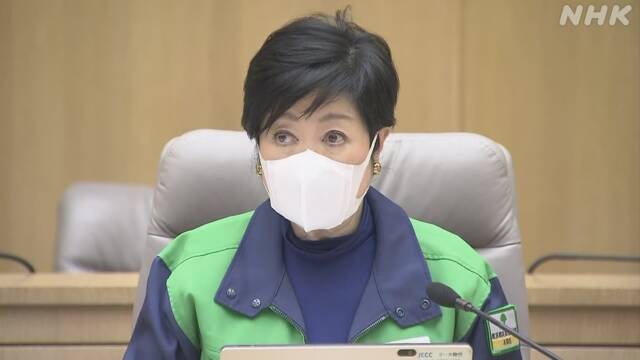At a monitoring meeting in Tokyo, experts said that the current situation has been prolonged, saying that the large-scale spread of the new coronavirus has continued in Tokyo, and that the number of inpatients and severely ill patients has remained high. For example, he warned that the medical care provision system would face a crisis.
At the meeting on the 25th, experts maintained the alert level of the infection situation and the medical care provision system in Tokyo at the most serious level of the four stages.
Of these, the infection status was analyzed as "a large-scale spread of infection continues."
The seven-day average of new positives was 13,057 as of the 23rd, down 90% from the previous week, but experts pointed out that "it's still very high."
He expressed concern that "if the rate of increase increases even slightly, there is a risk of re-spreading the infection," and said that everyone could become an infected person or a close contact, and repeatedly called for thorough measures. rice field.
Experts also analyzed that the medical care provision system is "tight."
As of the 23rd, there were 4172 inpatients and 80 severely ill patients, both of which were almost the same as the previous week and remained at high values. The provision system faces a crisis. "
Furthermore, the general sickbeds continue to be full, and medical staff become infected or become close contacts, and labor shortages have become normal, making it extremely difficult for emergency medical institutions to accept emergency patients. I pointed out.
According to experts, the number of people with severe illness is 208 as of the 23rd, an increase of more than 30 from the previous week, such as performing "high flow therapy" that administers a large amount of high-concentration oxygen. explained.
Experts pointed out that it is important to know the number of moderately ill patients because a certain percentage of moderately ill patients are seriously ill.
Let's take a concrete look at the number of inpatients and the number of severely ill patients in Tokyo.
Number of inpatients
The number of inpatients in Tokyo has exceeded 4,000 on February 7, and has continued to be in the 4,000 range.
Although it will not exceed 4351 on September 4, last year, which is the highest number ever, it reached 4273 on the 19th, the highest number in the 6th wave.
After that, it has been almost flat, and as of the 24th, there are 4163 people.
Experts explained that 73% of inpatients were in their 60s or older as of the 23rd, saying, "The number of inpatients in the elderly and their proportion are increasing, and medical institutions need a lot of manpower. It has become like that. "
Number of severely ill patients
In addition, the number of severely ill patients using respirators, etc., aggregated according to the city's standards, remained almost unchanged, with 87 on February 19 and 20, the highest number in the 6th wave, and as of 24th. There are 81 people.
More than 80% of severely ill patients are in their 60s or older, and experts said, "Even if pneumonia is mild, the number of patients requiring intensive care due to other coexisting diseases is also high, so it is necessary to be cautious about the increase. There is. "
Increased infection to highly infectious "BA.2" More than 80% are community-acquired
It has been pointed out that the virus of the strain called "BA.2", which is a kind of Omicron strain, is more infectious than the virus that is currently spreading.
In Tokyo, 6 people have been confirmed to be infected with this virus by genome analysis conducted by the city, etc., targeting people who were confirmed to be infected with the new coronavirus in December last year and January this year. It was done.
At the monitoring meeting, the latest analysis results were revealed.
According to that, the number of people increased by 24 to 30 in total.
Of the 30 people, 25, which is more than 80%, have no history of traveling abroad, and no contact with people who have traveled abroad has been found, so it is considered to be a community-acquired infection.
In addition, as a result of conducting a PCR test on 104 people to find the "BA.2" strain virus in the week until February 21, 4 people are suspected of being infected with this virus. It means that I understood.
Excluding those who could not be determined, suspicion of infection was 4.2% of the total, an increase of 2.9 points from 1.3% in the previous week.
Experts said, "There is an increasing trend in the rate of BA.2 virus outbreaks. This virus is said to be more infectious, so caution is required and we will continue to monitor the trend." I'm talking.
Nearly half of the elderly in Tokyo are vaccinated for the third time
At a monitoring conference in Tokyo, it was reported that nearly half of the elderly people aged 65 and over in Tokyo completed the third booster vaccination.
According to this, as of the 23rd, 1,234,747 people aged 18 and over in Tokyo, or 19.6%, completed the third vaccination.
The inoculation rate is 0.3 points higher than the national average.
Of these, 1,560,055 elderly people aged 65 and over have an inoculation rate of 48.0%, which is 6 points higher than the national average.
Experts say, "Since the third booster vaccination can be expected to be effective against Omicron strains, it is necessary to secure the vaccine at an early stage and promote the vaccination to the desired citizens of Tokyo."

